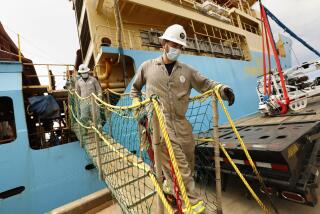Getting to the Bottom of Things : Geology: Scientists drill the sea floor to probe Earth’s crust for data on the rearrangement of continents, climate changes, currents and the planet’s magnetic field.
- Share via
Imagine trying to drill a hole in the sidewalks of New York from atop the Empire State Building using a strand of spaghetti.
That’s what Philip Rabinowitz says drilling the floor of the ocean is like.
Even in the calmest waters, punching holes in the sea bottom is tricky business, said Rabinowitz, a founder of the 19-nation Ocean Drilling Program.
Probes into the Earth’s crust, some as deep as 1.25 miles, are turning up new information about such basic processes as the rearrangement of continents, the evolution of sea life, global climate changes, ocean currents, worldwide sea levels and the planet’s magnetic field.
Since 1985, the program’s drill ship, JOIDES Resolution, has extracted more than 330,000 linear feet of cores from 865 holes in the world’s ocean basins.
“Considering the vast area covered by the oceans, it’s an infinitesimal amount,” said Rabinowitz, a scientist at Texas A&M; University.
“It’s the equivalent of having just a couple of holes in the state of Texas, for example, and trying to learn about the geology of the state based on those holes,” he said. “So our work is still in its infancy.”
The U.S. National Science Foundation and 18 member countries pay $44 million a year to finance the Ocean Drilling Program, which is coordinated by Texas A&M.;
The program supports six eight-week cruises annually by the 473-foot-long JOIDES Resolution. (The ship’s first name stands for Joint Oceanographic Institute for Deep Earth Sampling.)
Drilling in 12,000-foot-deep water in mid-ocean east of Miami, scientists and technicians recently burrowed into a 50,000-year-old mineral deposit on the Mid-Atlantic Ridge.
“It looks like the sulfide deposit is on the order of 4 million tons and contains copper, iron and zinc,” said the project’s co-chief scientist, Susan E. Humphris. “It might be the largest ever found on the ocean floor.”
Material extracted from the mineral mound will be studied to determine how such ore deposits are formed and how they change over time.
“It might also tell us where else you might find them on land,” said Humphris, a geologist at the Woods Hole Oceanographic Institution in Massachusetts. “So far, the best examples of similar land-based deposits are in Cyprus, Oman and Newfoundland, Canada.”
Cores of sediments and other materials collected from the ocean bottom are returned to the ship in 20-foot-long flexible cylinders and then sliced into 5-foot sections for easier handling.
Scientists study the cores at laboratories in Texas, California, New York and Germany.
What they learn is vital to understanding global structure and evolution. Earth’s surface constantly rearranges itself at a leisurely pace. Internal heat, seeking to escape, sets continents and ocean floors in motion, causing earthquakes and volcanic eruptions.
On a JOIDES Resolution cruise in 1993, a seismometer was planted in a hole deep beneath the Sea of Japan. “It’s the first ever placed beneath the sea floor, and we hope it will eventually be part of a worldwide network of seismometers that will predict earthquakes,” Rabinowitz said.
A 202-foot derrick amidships on the JOIDES Resolution enables technicians to drill in water nearly 27,000 feet deep. The ship can suspend as much as 30,000 feet of pipe to obtain core samples.
Scientists and drilling crews work 12-hour shifts, sometimes longer. It takes 12 hours for a drill bit at the end of 18,000 feet of pipe to reach the sea floor through a 23-foot-diameter opening in the bottom of the ship.
Then, in a seven-story shipboard research center, the scientists analyze the core samples of rocks and sediments that emerge dripping from the deep. In the paleontology laboratory, experts can retrieve millions of microfossils from sediment samples smaller than a teaspoon.
The shipboard work leaves a lasting impression on some participants. Brian T. Huber, a Smithsonian Institution paleobiologist, said, “It was probably the most intense scientific experience I’ve ever had.”






